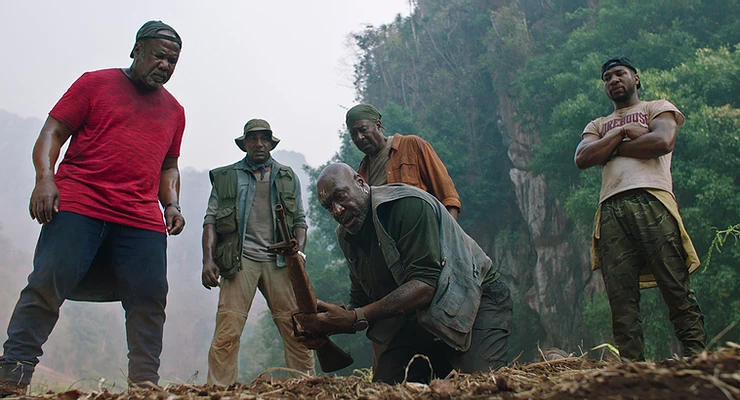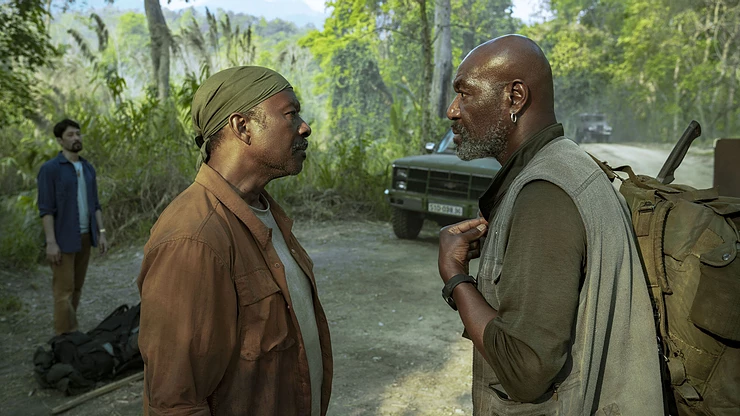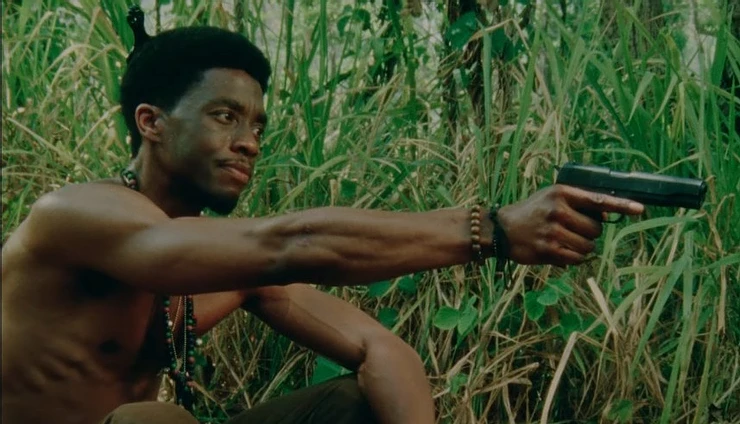Da 5 Bloods Review: A Powerful, Raw Return to the Vietnam War | Reupload

Fresh off his Oscar-winning movie BlacKkKlansman, Spike Lee is back with a film so relevant to today that it's hard to believe he didn’t just create it last week. At its core, Lee’s Da 5 Bloods is a raw, powerful examination of African American veterans who fought in another man’s war, while reconciling with the growing Civil Rights movement back home in the US. It’s a complex issue to unravel, and Spike Lee, for the most part, successfully manages to peel back some of these layers to deliver a compelling, hard-hitting story.
The story focuses on four Black Vietnam veterans: Paul (Delroy Lindo), Otis (Clarke Peters), Melvin (Isiah Whitlock Jr.), and Eddie (Norm Lewis), who venture back to the country decades later to locate the remains of their fallen squad leader ‘Stormin’ Norman (Chadwick Boseman) along with gold that they buried during the war. More than just unearthing buried gold, however, the soul of the story lies in the characters digging up the ghosts of the past, from a war that reshaped their ideals, scarring them physically and mentally.
We fought in an immoral war that wasn’t ours, for rights we never had.
All four veterans have their demons, but Delroy Lindo steals the show with a captivating performance as Paul. Paul is hit harder psychologically by the events of the war, becoming a myriad of contradictions and conflicting morals.
Paul is adorned in a red ‘Make America Great Again’ Trump cap and a T-shirt with a Punisher skull symbol – a symbol taken from Marvel’s The Punisher and provocatively worn by some US law enforcement to this day. This apparel forms part of Paul’s twisted way of dealing with the trauma of being a victim in a system that betrayed him: "We fought in an immoral war that wasn’t ours, for rights we never had.”

As the film progresses, the layers around Paul break away to reveal a broken, angry, PTSD-riddled man whose ghosts were never left buried in Vietnam in the first place. In truth, they never left his side from the moment the war ended. It’s a tragic, heart-wrenching portrayal that builds to a mesmerising third-act monologue from Lindo (with Lee using his classic double dolly shot) that drives home a message repeated throughout the film: for some, mainly African American and Vietnamese soldiers, the war never truly ended.
This isn’t to say that the remaining cast is left to the sidelines. Clarke Peters as Otis gives a sterling performance as the group's voice of reason. As a former medic, Otis finds himself fighting once more to hold his unit together. Boseman does a lot with a limited role as the squad’s former leader Norm, a near-mythical man (described as part MLK and part Malcolm X) who embodies the youthful ideals that never left Vietnam. Lastly, Jonathan Majors plays a great role opposite Lindo as David, Paul’s son who joins the group in one last bid to reconnect with his troubled father.
In terms of cinematography, Lee does an admirable job using it to juxtapose the past and present, laying out the complex racial and political history of the Vietnam War era and how it’s still very much relevant today. In the opening scene, we’re presented with archive footage of Muhammad Ali, who was firmly outspoken in his disapproval of the Vietnam War: “My conscience won’t let me go shoot my brother, or some darker people, or some poor hungry people in the mud for big powerful America.”

It then moves to a montage of archive footage depicting African American soldiers, the civil rights movement, and figures such as Angela Davis and Malcolm X, all to the tune of Marvin Gaye’s ‘Inner City Blues’. It’s a powerful opening that wastes no time in setting the foundation for the rest of the film, outlining racial disparities that are still so relevant today that Lee could have used footage from current events and been just as impactful.
Lee’s use of archival footage isn’t limited to the opening of Da 5 Bloods. Rather, it is used liberally throughout the film and is quite effective. It works for comedic gags and also provides quick context and weight to the historical significance of the dialogue.
Flashbacks are also used extensively, with scenes sometimes cutting to and from the Vietnam War mid-sentence. For the most part, this works well, as each time we jump back to the past, the aspect ratio changes to resemble that of a grainy 16mm camera. It sounds jarring on paper but flows quite well on screen.
What doesn’t work quite as well, though, is that during the flashback scenes, the rather middle-aged central cast still play their younger 20-something selves, alongside a still somewhat youthful Chadwick Boseman.

It is definitely a conscious decision on Spike Lee’s part to avoid the recasting or expensive digital de-aging routes, the latter of which is now more prevalent in modern cinema. While using the same older cast helps maintain the kinetic energy of the quick transitions between present and past, it is very noticeable and can be distractingly so.
Da 5 Bloods is a somewhat lengthy affair with a 2-hour and 30-minute runtime. It’s understandable given its dense historical context, but despite its length, it's not smooth sailing throughout. Da 5 Bloods has the DNA of the dark nature of Apocalypse Now and the renegade soldier-of-fortune plot of Three Kings ingrained into it. However, it’s when the story starts imitating the latter that the message gets a bit lost in the violence, particularly around the third act.
For some characters, the third act is less about coming to terms with demons or moments of catharsis and more about a violent shootout over reparations that are (literally) worth their weight in gold. This is Lee’s attempt to add more nuance – after all, there are no heroes in war – but some of the hard work he built up to that point is undone in the process.
Overall, Da 5 Bloods is some of Spike Lee’s greatest work to date, with strengths that more than make up for a few shortfalls along the way. It’s a bumpy road but one that delivers at the end of its destination.
Da 5 Bloods is available now on Netflix.

Post a comment